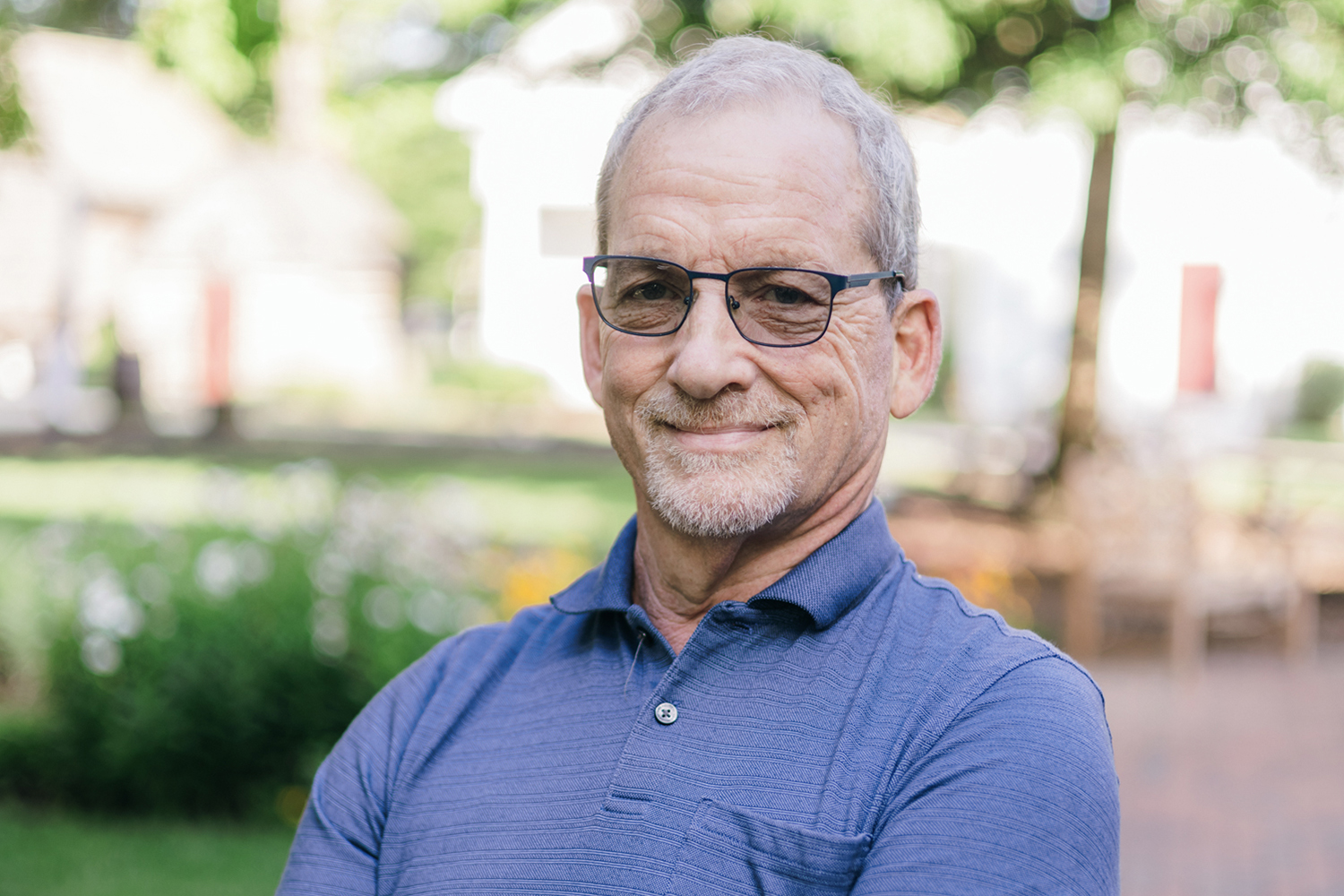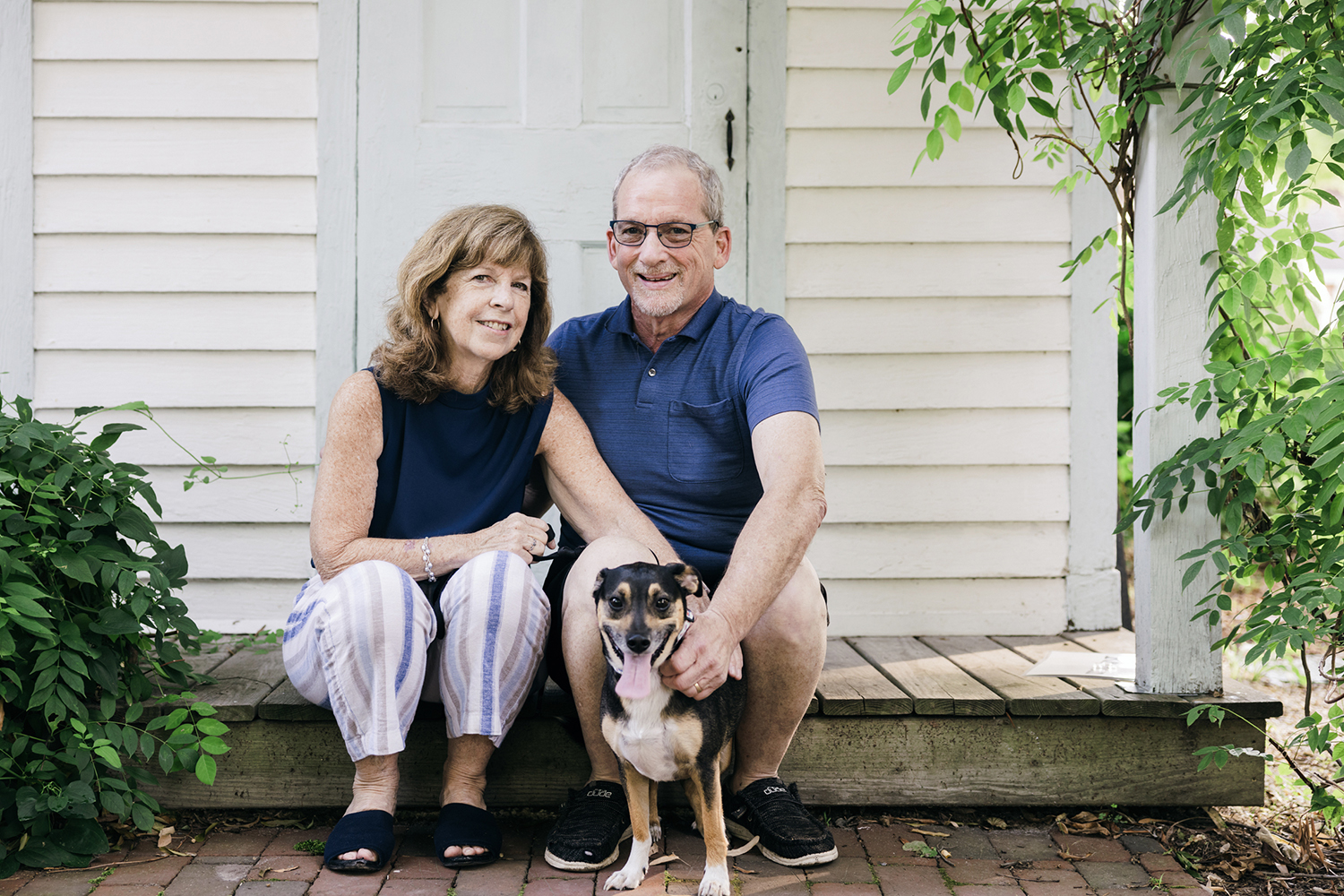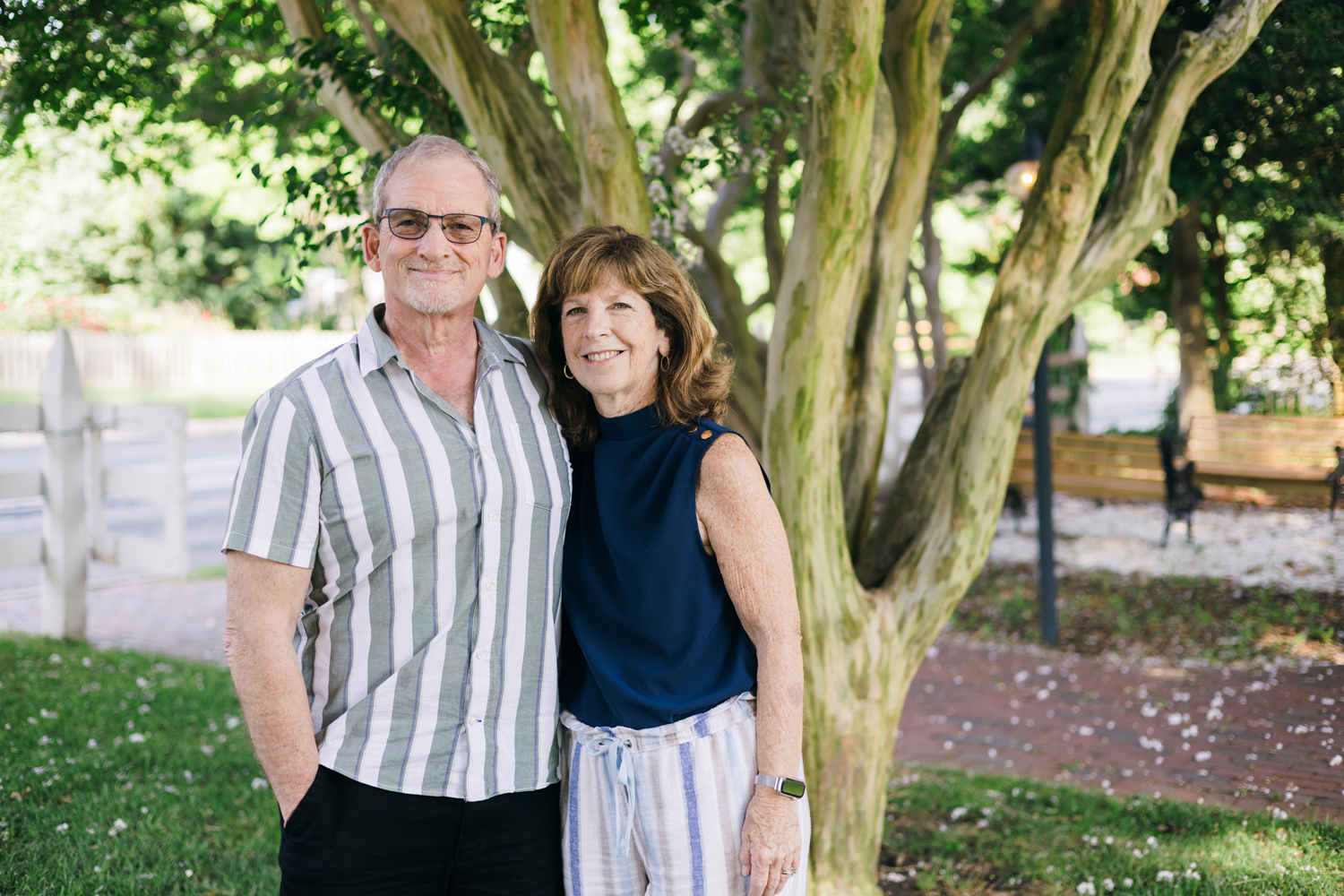MIKE HERMAN REMEMBERS that first sharp pain. In the fall of 2012, Herman was on a walk when he bent over to pick up a pair of eyeglasses he had just dropped. A stabbing pain cut through him, causing him to call out. Herman, then 50, assumed the stabbing sensation was just a sign of aging, but a few weeks later, while at work, he leaned over to pick up some files and again felt severe pain in his ribs.
An X-ray didn’t show any problems, but the pain persisted. Over the course of a few months, his physician ordered several tests, including bloodwork that revealed anemia, a condition where a low red blood cell count can cause bone pain, fatigue, weakness and shortness of breath. In May 2013, he was referred to a hematologist-oncologist, who suggested he take B12 supplements and return in three months. But Herman’s then-fiancée, Angela, who has a doctorate in nursing practice and serves as the director of the health sciences program at Wilmington University in Delaware, pushed for a bone survey, which uses a series of X-rays to look at all the bones in the body. That imaging test revealed tiny fractures in almost half of the bones in his ribs and more than 100 lesions on his bones throughout his body. Herman learned the cause of his pain and anemia: multiple myeloma, a rare and incurable form of blood cancer.
Since his diagnosis on June 4, 2013, Herman has sought the help of specialists across the country to direct his treatment, which has included two stem cell transplants more than 1,000 miles from the Hermans’ home in Bear, Delaware, and participation in two clinical trials. With support from Angela, who is now his wife, Herman has learned to advocate for himself.
Going from fearing that his days were coming to an end to helping others cope with their cancer, Herman started an advocacy group called Speaking on Cancer Patient Advocacy in 2022. The nonprofit offers resources to help educate people diagnosed with cancer in hopes they will push their doctors, nurses and other health care workers to provide compassionate and patient-centered care. “Our overarching goal is to have both health care professionals and patients have a deeper understanding of advocacy—both for self and for others. We feel this is a vital part of supporting patients through their cancer journey,” Herman says.
Learning From the Highs and Lows
Herman has experienced ups and downs in navigating a complex and sometimes impersonal health care system, and the downs have informed his advocacy work. He shakes his head when recounting how he learned about his diagnosis—through his patient portal. When he got a message on his phone the day his bone survey results were available, he assumed it would be good news. “I was happy because there’s no way they would tell me I had cancer this way,” he says.
He opened the message and read it several times, thinking he was missing something. Then, he called and read the results to Angela. “She hesitated maybe a second, and that’s when I knew I had cancer,” he says.

Photo by Tiffany Caldwell
He started treatment with a three-drug regimen of Revlimid (lenalidomide), Velcade (bortezomib) and dexamethasone, which is the standard-of-care first-line treatment for multiple myeloma. The couple also researched multiple myeloma specialists around the U.S., meeting with doctors at the Johns Hopkins Kimmel Cancer Center in Baltimore, the Abramson Cancer Center at Penn Medicine in Philadelphia and Dana-Farber Cancer Institute in Boston for second opinions. From the start, Angela encouraged her husband to be proactive in seeking specialists who met his needs, were involved in clinical trials and had published research.
Reading through these studies led Herman to hematologist-oncologist Bart Barlogie, who pioneered some of the early treatments for multiple myeloma, including the use of tandem stem cell transplants to boost remissions. In January 2014, the Hermans drove from their home in Delaware to meet with Barlogie at what is now called the Myeloma Center at the University of Arkansas for Medical Sciences Winthrop P. Rockefeller Cancer Institute in Little Rock, not expecting treatment to begin immediately.
“We weren’t prepared for that,” Angela says. “No one thought we’d be there for nine months.” During that prolonged stay, Herman underwent two stem cell transplants using his own stem cells, which were harvested from his bone. As part of the process, he received high-dose chemotherapy prior to the transplants. Before the first transplant, he developed pneumonia, and following the second, he had a bowel perforation, which extended his treatment timeline.
“It was quite an undertaking,” Angela says, adding she was grateful they had the support of friends and family during these months. She created a master calendar to track who would stay with Herman in a rented apartment in Little Rock. “I never wanted him to be alone down there,” she says. She often traveled between Delaware and Arkansas, still working her job at a Delaware hospital and keeping up with the couple’s blended family of five adult children and their growing number of grandchildren.
Patients who share their experiences can be a valuable resource to others with questions about treatment and clinical trial participation.
Mike Herman makes a point to share the experiences he’s had participating in clinical trials with other people with cancer. Since being diagnosed with multiple myeloma in 2013, he has described how he benefited from two experimental drugs—one of which has recently been approved by the Food and Drug Administration.
Patients like Herman who participate in clinical trials continue to impress Kiran Reddy, a physician and senior managing director at Blackstone Life Sciences, who arranged for Herman and his wife, Angela, to speak at the company’s annual conference recently.
“It wasn’t too long ago that a diagnosis of multiple myeloma was really a terrible one. … You do your research on Google and realize the five-year survival was low, and that was what [Herman] was facing at that time,” says Reddy.
For Herman, information is key. He recalls giving a talk to patients at a different event and being asked if he had ever undergone a bone marrow biopsy, a procedure where a needle is inserted in the bone to remove a bone marrow sample that can be used to look for cancer and other diseases. Herman explained his bone biopsy was very uncomfortable, especially when the needle was pulled out, but the pain went away.
After the session ended, a woman in tears approached the patient advocate who organized the event. She was getting a bone marrow biopsy a few days later and had not slept in more than two days because she was so worried about the procedure. But after hearing Herman talk about his experience, she told the advocate that she felt relieved. “She was crying from happiness,” Herman says. She was going home to sleep because she knew what to expect.
Earlier this year, Herman was one of 39 patients chosen for the American Association for Cancer Research (AACR) Scientist↔Survivor Program, which provides training for patient advocates during the AACR Annual Meeting. (The AACR publishes Cancer Today.) He and the other patient advocates attended the AACR Annual Meeting 2024 in San Diego to learn about cancer discoveries, policy changes and other ways research impacts them and others.
This was not the couple’s first time dealing with adversity. In November 2012, just seven months before Herman was diagnosed with cancer, Angela’s youngest child and her only son, Peter DiSabatino, 20, was shot and killed outside his college apartment. “[Then] when Michael got diagnosed, it was really hard,” Angela says. “We were put together to help each other cope. The grief [of losing Peter] never goes away.”
But the couple moved forward. They bought a house together and were married in the backyard in September 2013—months after his diagnosis. Then, it was off to Arkansas for treatment. It was a long road to recovery once Herman returned home to Delaware in early fall 2014 after his stem cell transplants. At first, he was so weak that he struggled to do much of anything, he says. The couple got a rescue dog for companionship and named him Barlogie after the doctor who treated Herman.
“It was hard getting back to normal,” says Herman, now 62. He compares going up the stairs for bedtime to “climbing a mountain,” but he refused to sleep downstairs so he and his wife could sleep together in their bedroom and maintain a sense of normalcy.

Mike Herman and his wife, Angela, adopted a dog for companionship during Herman’s treatment for multiple myeloma. They are shown with their current dog, Levi. Photo by Tiffany Caldwell
In 2019, he was prescribed the immunotherapy drug Darzalex (daratumumab) that led to a sustained remission of about a year. But the cancer returned in 2020, leading Herman to take part in his first clinical trial from October 2020 to April 2022 at the Abramson Cancer Center at Penn Medicine. The drug being tested was teclistamab, a T-cell-redirecting bispecific antibody that would later be approved under the brand name Tecvayli for people who’ve been repeatedly treated for multiple myeloma. It works by binding to both multiple myeloma cells and T cells, helping the immune system recognize and destroy the multiple myeloma cells.
Herman stayed in the hospital while the drug was administered through injections. Not long after getting the first shot of the drug, he experienced pain so intense he was kneeling on the bed and “cursing like a drunken sailor,” he says. The pain continued for hours, but after two days of the treatment, his doctor called to report the level of cancer detected in his bloodstream had dropped by more than 99%.
Herman wishes his medical team had warned him what to expect from the treatment. If he had known severe pain could be a sign the drug was working, those first few days would not have been as difficult. “Psychologically, it would have been easier to handle,” he says.
The couple applied what they had learned when Herman joined a second clinical trial in July 2022, also at Penn Medicine, this time to receive 17 cycles of an experimental bispecific antibody called cevostamab. At the start of the clinical trial, the Hermans discussed their concerns about pain management with members of the care team, who assured them they would be proactive in managing pain. “We were prepared, and they were prepared,” Angela says.
The couple encourages all people with cancer to ask many questions as they weigh their treatment options. They also encourage health care workers to ask patients how much information they want to receive because it can vary from one person to the next.
The second clinical trial ended in July 2023, and there have been no signs of cancer since, Herman says. After both clinical trials, he was told his cancer was undetectable. He’s on hiatus from treatment for the first time since being diagnosed with multiple myeloma more than a decade ago, though he’s quick to note multiple myeloma currently has no cure. He expects, at some point in the future, the cancer will return, and he’ll need to be treated again.
Making a Difference
For now, Herman receives quarterly blood tests at Penn Medicine, which is part of the follow-up for the cevostamab clinical trial. At a local hospital in Delaware, he undergoes monthly blood tests, as well as intravenous immunoglobulin injections, which provide antibodies to help his body fight infections. The transition away from active treatment has been jarring. “What do you mean stop my drugs? I’m healthy, and they’ve kept me alive this long,” Herman remembers thinking when he completed the second clinical trial last year.
The break in treatment has given him time to think about how he might help others, particularly as his nonprofit organization plans to introduce a pilot program that integrates cancer prevention and screening initiatives into high school health curriculums. “The National Cancer Institute says more than 40% [of Americans] will get cancer in our lifetime, yet we treat it in a very reactive way,” Herman says. He hopes students will learn about cancer and advocacy before they or someone they know gets diagnosed.
Herman is “exploding with all these ideas,” Angela notes, and he’s driven to make a difference through education and sharing his experiences. Herman calls Angela his “great advantage.” She was the one who reminded him that they would get through this. And after the initial shock and the numerous treatments, that’s what they did and continue to do. “Undetectable” has become his new favorite word.
Cancer Today magazine is free to cancer patients, survivors and caregivers who live in the U.S. Subscribe here to receive four issues per year.





